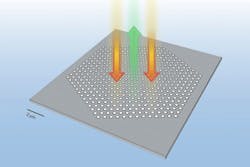Stanford researchers design a light-trapping, color-converting photonic crystal
Frequency conversion of light, such as frequency doubling, is done using a nonlinear optical crystal, usually in bulk form. Miniaturizing this process can be done by creating a photonic crystal (PhC) out of a nonlinear optical material—however, creating such a device with a photonic bandgap for both the original and frequency-converted light is difficult, preventing the design of microscopic frequency converters.
Postdoctoral scholar Momchil Minkov and Shanhui Fan, professor of electrical engineering, both at Stanford University (Palo Alto, CA) have developed guidelines for creating a PhC structure with an unconventional two-part form that solves this problem.1
Rather than trying to create a PhC that itself has two bandgaps, the researchers developed a version that confines the fundamental frequency via a conventional bandgap, while confining the doubled frequency using a "bound state in the continuum," or BIC. Such a state is a single frequency that is localized even though frequencies all around it are unbound; a BIC is a particular type of resonance in which scattering and interference create the bound state.
After ironing out the details of their two-part structure, the researchers produced a list of four conditions, which should guide colleagues in building a photonic crystal cavity capable of holding two very different wavelengths of light. Their result reads more like a recipe than a schematic because light-manipulating structures are useful for so many tasks and technologies that designs for them have to be flexible.
"We have a general recipe that says, 'Tell me what your material is and I'll tell you the rules you need to follow to get a photonic crystal cavity that's pretty small and confines light at both frequencies,'" says Minkov.
The researchers are beginning to fabricate their photonic crystal cavity for experimental testing.
Source: https://news.stanford.edu/2019/08/07/light-trapping-color-converting-crystal/
REFERENCE
1. Momchil Minkov, Dario Gerace, and Shanhui Fan, Optica (2019); https://doi.org/10.1364/optica.6.001039.
About the Author
John Wallace
Senior Technical Editor (1998-2022)
John Wallace was with Laser Focus World for nearly 25 years, retiring in late June 2022. He obtained a bachelor's degree in mechanical engineering and physics at Rutgers University and a master's in optical engineering at the University of Rochester. Before becoming an editor, John worked as an engineer at RCA, Exxon, Eastman Kodak, and GCA Corporation.

